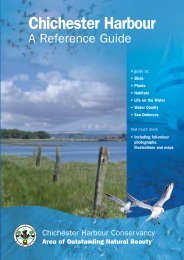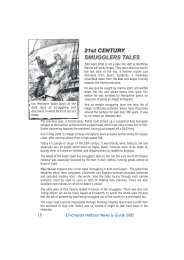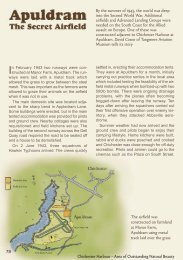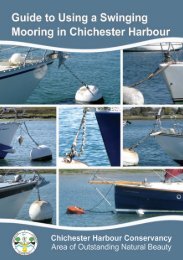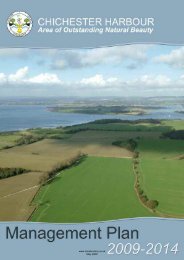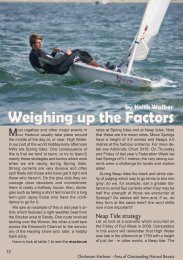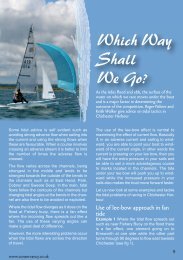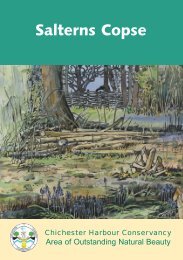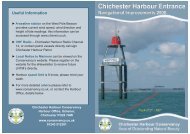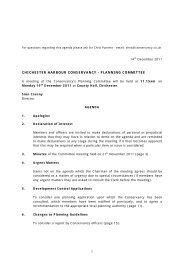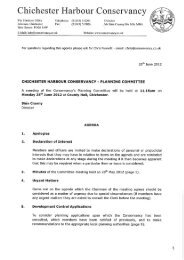Iron Age â 600 BC-AD 43 - Chichester Harbour Conservancy
Iron Age â 600 BC-AD 43 - Chichester Harbour Conservancy
Iron Age â 600 BC-AD 43 - Chichester Harbour Conservancy
Create successful ePaper yourself
Turn your PDF publications into a flip-book with our unique Google optimized e-Paper software.
In addition to this, the channels of the harbour offered good transport. Many of the known<br />
salt workings in the AONB are concentrated on Chidham’s west coast and at the head of<br />
Thorney Channel. <strong>Iron</strong> <strong>Age</strong> salt works were surveyed by Bradley and some are known<br />
from excavations at Chidham (Bedwin 1980) (Chi SMR 205, 251; 477930 103830, 477900<br />
103780). At Bradley’s salt working site 18, the latter of these two sites, a small Early <strong>Iron</strong><br />
<strong>Age</strong> pit may have been an evaporation pan for salt production. Both sites were also yielded<br />
Neolithic pottery. Another salt working site at Chidham (Chi SMR 248; 478200 103930),<br />
Bradley’s site 19, the finds of calcinated flint, a few <strong>Iron</strong> <strong>Age</strong> and Roman sherds and a few<br />
fragments of burnt clay, may have been instead associated with ploughing in the area<br />
(Bedwin 1980). Slightly further north up the coast at Nutbourne Creek, a Middle to Late<br />
<strong>Iron</strong> <strong>Age</strong> salt working site (Chi SMR 240; 477980 103480) was also found (Bradley’s Site<br />
B) in addition to a Roman inhumation.<br />
Salt workings are also to be found at the north end of Thorney Channel. Bradley’s site 18<br />
(Chi SMR 250; 477570 104810) is located below the high water mark and the dating is<br />
imprecise (Bedwin 1980). Bradley’s site 16 (Chi SMR 253; 476990 104730) yielded a<br />
large feature with sherds of pottery and calcinated flint. Cartwright’s site CH-52 (Chi SMR<br />
220; 478000 103<strong>43</strong>0) yielded a number of Early <strong>Iron</strong> <strong>Age</strong> and Late <strong>Iron</strong> <strong>Age</strong>/Romano-<br />
British sherds (Cartwright 1984). At Thornham Boat Yard, <strong>Iron</strong> <strong>Age</strong> occupation debris of<br />
‘uncertain nature’ (Chi SMR 244; 476350 104710) was overlain by a large 1st century<br />
Roman saltern.<br />
Two <strong>Iron</strong> <strong>Age</strong> salt workings were located on the headland between Bosham and Bosham<br />
Hoe. Bradley’s Site 20 (Chi SMR 254; 479770 102780) consisted of five badly struck cores<br />
and flakes and a scatter of calcinated flint on the shore. Bradley’s site 21 (Chi SMR 255;<br />
479800 102490) included fired clay fragments, but these were probably not briquetage<br />
(Bedwin 1980).<br />
The <strong>Iron</strong> <strong>Age</strong> has other evidence for industrial activity where it is less clear what processes<br />
were taking place. Four hearths were visible in 1969 in a section of low sea cliff opposite<br />
Verner Common (Hants SMR 23,519.00, 23,520.00, 23,521.00, 23,522.00; 473400<br />
101670, 473420 101640, 473450 101510, 473450 101460 respectively). These hearths<br />
were thought to be <strong>Iron</strong> <strong>Age</strong>, although no finds were retrieved. It is plausible that they were<br />
associated with salt working, but this is speculation.<br />
<strong>Iron</strong> <strong>Age</strong> settlements, major hillforts, and cemeteries are all known from the wider area<br />
outside the AONB, for example at <strong>Chichester</strong>, the Trundle and Westhampnett. However,<br />
no evidence for <strong>Iron</strong> <strong>Age</strong> settlement has been found within the AONB itself, or indeed in<br />
the adjacent Langstone harbour (Allen and Gardiner 2000). Even short-term and temporary<br />
timber structures, like that identified in other areas of <strong>Iron</strong> <strong>Age</strong> wetlands with salt marsh<br />
(Bell et al 2000), have not been identified, although that is not to say that they will not be<br />
found in the future.<br />
However, although evidence is lacking, an obvious candidate for at least Late <strong>Iron</strong> <strong>Age</strong><br />
settlement is Fishbourne. It was a pivotal early Roman site. In fact, Fishbourne may have<br />
started life as a placed trading post. Similarly, the fact that <strong>Iron</strong> <strong>Age</strong> pottery is scattered<br />
across the AONB suggests that there may at least have been temporary or seasonal<br />
occupation. Often the pottery has been found in association with pot boilers (large firecracked<br />
pebbles heated in a fire and placed in a liquid to boil it), for example at Thorham<br />
Point (Chi SMR 177, 178; 476550 104400, 476580 10<strong>43</strong>70), on Hayling Island (Hants<br />
SMR 23,569.00; 473670 102510) and at Cartwright’s site CH-61 (Chi SMR 231; 476930<br />
104880). This last find is interesting, since <strong>Iron</strong> <strong>Age</strong> pottery has been found on other<br />
36



